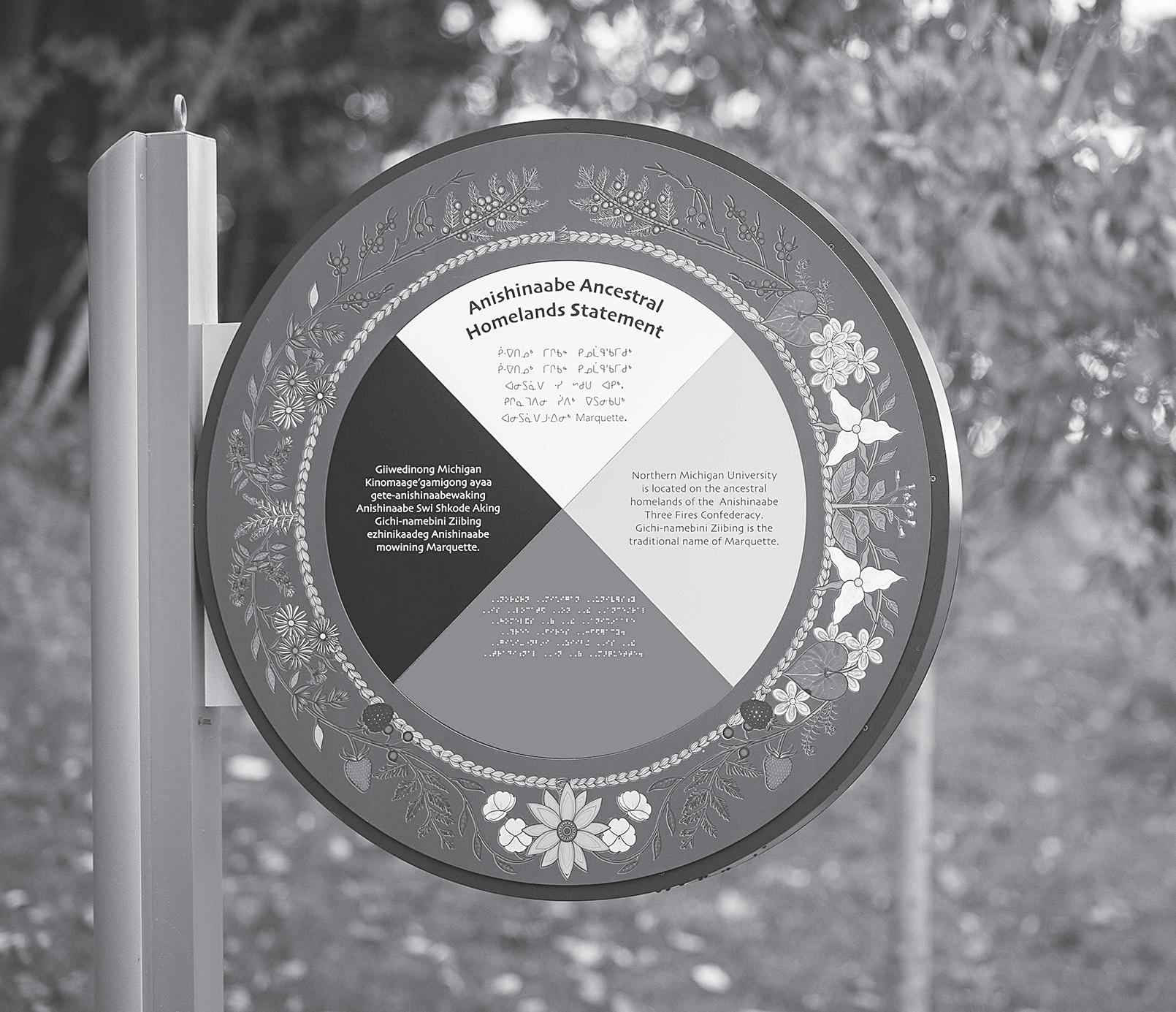
7 minute read
On Campus

HOMELANDS SIGN
Advertisement
NMU acknowledges campus built upon ancestral indigenous lands
By Kristi Evans
Northern Michigan University honored Indigenous Peoples’ Day Oct. 11 with an unveiling ceremony for a new sign on the academic mall acknowledging that the campus is located on the ancestral homelands of the Anishinaabe Three Fires Confederacy.
The event included songs by the Morning Thunder Drum, speakers and a group procession to the Center for Native American Studies’ fire site near Whitman Hall.The Native American Student Association selected “A Day of Healing and Celebration” as the theme of this year’s event. NASA President Bazile Panek said it falls in the midst of the continuing pandemic, as “American Indians and Alaska Natives are dying of COVID-19 at much higher rates and at younger ages than any other group.”
Grace Challier, a Center for Native American Studies faculty member, has taught a course on the history of Indian boarding schools for the past 14 years. She read a relevant short essay titled “In Defiance” by NMU student Shelby Boggs, a double major in Native American studies and social work.“The United States has committed 500 years of genocide against the Indigenous people of Turtle Island in an attempt to further the capitalization of the land,” Boggs wrote.
“The most insidious act of genocide was that of the Indian boarding school system, which operated for nearly 100 years through both governmental and church oversight. The main advantage for the dominant society to operate these institutions was gaining control over Indigenous people through systematic dehumanization and traumatization. Nevertheless, in spite of 500 years of genocide and forced assimilation, Indigenous people and culture prevail.”
Professor Martin Reinhardt of the Center for Native American Studies read comments from NMU Interim President Kerri Schuiling, who was unable to attend because of a flight cancellation. “In spite of the atrocities Indigenous peoples suffered and endured, it is our Native American communities that have consistently taught us the importance of leaving the world in a better place than we found it,” Schuiling wrote. “Getting to today has been a journey that has taken a lot of time, patience and work on behalf of many people.”
Dan Truckey of the Beaumier U.P. Heritage Center chaired the committee responsible for installing the land acknowledgment sign.
“One thing I was told right off the bat was that a sign was not enough because that in itself was a sign of colonization; we needed something more lasting and meaningful,” Truckey said. “In addition to the sign, there is going to be an interpretive walk in this forest area directly behind it. This is the remnant of a forest that once stretched throughout this whole area. We thought, how fitting would it be for this forest to have a new life, where it actually serves as an interpretation of the Anishinaabe people and the things they value in their lives. For that reason, we chose this location for the sign as an entryway into the forest and trail.”
NMU student Reese Carter, an illustration and Native American studies major, designed the multi-language sign that reads, “Northern Michigan University is located on the ancestral homelands of the Anishinaabe Three Fires Confederacy. Gichi-namebini Ziibing is the traditional name of Marquette.”
Kristi Evans is the news director for the NMU office for News and Media Relations.

On Indigenous Peoples’ Day, Oct. 11, NMU held a ceremony unveiling a new sign that recognizes that the campus is located on the ancestral homelands of the Anishinaabe Three Fires Confederacy. (NMU phtoto)
Finlandia offering students free META mental health services
Finlandia University has begun offering META Teletherapy to students. All Finlandia University students will have free access to META’s mobile app. Students can connect to a national network of licensed counselors and therapists for chat, voice, and video sessions. Students download the app, choose a provider, and receive counseling through the privacy and convenience of their smart phones.
The platform provides students the freedom to choose a therapist who’s a good fit, and the ability to reach them quickly and easily. Students attending online, out-of-state, and in-person will have equivalent access to mental health counseling services. A limited number of counseling sessions with META providers will be paid for by Finlandia University. META providers also accept insurance co-pay and out-of-pocket payments.
Leading Finlandia’s partnership with META is Rev. Sarah Semmler Smith, Finlandia’s campus pastor. “Part of Finlandia’s mission is to support the whole person toward a whole life. This partnership with META arises from the need to provide easier access to a broader variety of mental health providers to our students. META is an extension of the in person, on-site care we strive to provide our students every day,” Semmler Smith said.
Since the COVID pandemic, student engagement on META has increased dramatically. Providers on META’s marketplace are available days, evenings, and weekends all year long to fit a flexible student schedule.
For more information visit www. finlandia.edu
MTU team works to teach self-driving vehicles to navigate in snowy weather
By Allison Mills
Nobody likes driving in a blizzard, including autonomous vehicles. A major challenge for autonomous vehicles is navigating bad weather. Snow confounds crucial sensor data that helps a vehicle gauge depth, find obstacles and keep on the correct side of the yellow line, assuming it is visible. In two papers presented at the SPIE Defense + Commercial Sensing 2021 symposium, researchers from MTU discussed solutions for snowy scenarios that could help bring selfdriving options to snowy cities like Chicago, Detroit, Minneapolis and Toronto.
Automakers and research universities are still tweaking self-driving technology and algorithms. Occasionally accidents occur, either due to a misjudgment by the car’s artificial intelligence (AI) or a human driver’s misuse of self-driving features. Fisheye cameras widen the view while other cameras act much like the human eye. Infrared picks up heat signatures. Radar can see through the fog and rain. Light detection and ranging (lidar) pierces through the dark and weaves a neon tapestry of laser beam threads.
“Every sensor has limitations, and every sensor covers another one’s back,” said Nathir Rawashdeh, assistant professor of computing in Michigan Tech’s College of Computing and one of the study’s lead researchers. He works on bringing the sensors’ data together through an AI process called sensor fusion. “Sensor fusion uses multiple sensors of different modalities to understand a scene,” he said. “You cannot exhaustively program for every detail when the inputs have difficult patterns. That’s why we need AI.”
Rawashdeh’s Michigan Tech collaborators include Nader Abu-Alrub, his doctoral student in electrical and computer engineering, and Jeremy Bos, assistant professor of electrical and computer engineering, along with master’s degree students and graduates from Bos’s lab: Akhil Kurup, Derek Chopp and Zach Jeffries.
Most autonomous sensors and self-driving algorithms are being developed in sunny, clear landscapes. Bos’ lab began collecting local data in a Michigan Tech autonomous vehicle (safely driven by a human) during heavy snowfall. Rawashdeh’s team, notably Abu-Alrub, poured over more than 1,000 frames of lidar, radar and image data from snowy roads in Germany and Norway to start teaching their AI program what snow looks like and how to see past it.“All snow is not created equal,” Bos said, pointing

Sensors blocked by salt, ice, etc. are an obstacle a team at MTU is working on to help autonomous vehicles operate in bad weather. (Pexels photo by Pixabay)
out that the variety of snow makes sensor detection a challenge. Rawashdeh added that pre-processing the data and ensuring accurate labeling is an important step to ensure accuracy and safety. Still, clear vehicle sensors do not always agree. Bos mentioned an example of discovering a deer while cleaning up locally gathered data. Lidar said that blob was nothing (30 percent chance of an obstacle), the camera saw it like a sleepy human at the wheel (50 percent chance), and the infrared sensor shouted WHOA! (90 percent sure that is a deer). Getting the sensors and their risk assessments to learn from each other is like the Indian parable of three blind men who find an elephant: each touches a different part of the elephant — the creature’s ear, trunk and leg — and comes to a different conclusion about what kind of animal it is.
Using sensor fusion, Rawashdeh and Bos want autonomous sensors to collectively figure out the answer — be it elephant, deer or snowbank. As Bos puts it, “Rather than strictly voting, by using sensor fusion we will come up with a new estimate.”While navigating a Keweenaw blizzard is a ways out for autonomous vehicles, their sensors can get better at learning about bad weather and, with advances like sensor fusion, will be able to drive safely on snowy roads one day.
Allison Mills is the director of research news for the MTU Office for Marketing and Communications. Edited for space, visit mtu.edu/news for the complete story.













